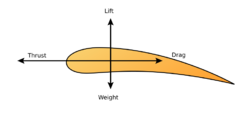Aerodynamic force
Topic: Physics
 From HandWiki - Reading time: 2 min
From HandWiki - Reading time: 2 min

In fluid mechanics, an aerodynamic force is a force exerted on a body by the air (or other gas) in which the body is immersed, and is due to the relative motion between the body and the gas.
Force
There are two causes of aerodynamic force: [1]:§4.10[2][3]:29
- the normal force due to the pressure on the surface of the body
- the shear force due to the viscosity of the gas, also known as skin friction.
Pressure acts normal to the surface, and shear force acts parallel to the surface. Both forces act locally. The net aerodynamic force on the body is equal to the pressure and shear forces integrated over the body's total exposed area.[4]
When an airfoil moves relative to the air, it generates an aerodynamic force determined by the velocity of relative motion, and the angle of attack. This aerodynamic force is commonly resolved into two components, both acting through the center of pressure:[3]:14[1]:§ 5.3
- drag is the force component parallel to the direction of relative motion,
- lift is the force component perpendicular to the direction of relative motion.
In addition to these two forces, the body may experience an aerodynamic moment.
The force created by propellers and jet engines is called thrust, and is also an aerodynamic force (since it acts on the surrounding air). The aerodynamic force on a powered airplane is commonly represented by three vectors: thrust, lift and drag.[3]:151[1]:§ 14.2
The other force acting on an aircraft during flight is its weight, which is a body force and not an aerodynamic force.
See also
References
- ↑ 1.0 1.1 1.2 Clancy, L.J. (1978). Aerodynamics. New York: Wiley. ISBN 0-273-01120-0. OCLC 16420565.
- ↑ Massey, B. S. (Bernard Stanford) (1998). "10.8.2". Mechanics of fluids. 2. Ward-Smith, A. J. (Alfred John) (7th ed.). Cheltenham, England: S. Thornes. ISBN 0-7487-4043-0. OCLC 40928151.
- ↑ 3.0 3.1 3.2 Hurt, H.H. Jr. (1965). Aerodynamics for Naval Aviators NAVAIR 00-80T-80. U.S. Navy. pp. 14, 29, 151. https://www.faa.gov/regulations_policies/handbooks_manuals/aviation/media/00-80T-80.pdf.
- ↑ Anderson, John D., Jr. (John David), 1937- (1999). "2.2". Aircraft performance and design. Boston: WCB/McGraw-Hill. ISBN 0-07-001971-1. OCLC 40076736.
 |
 KSF
KSF
